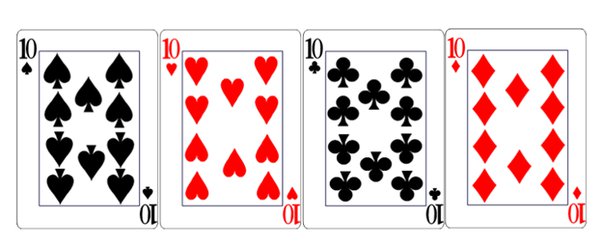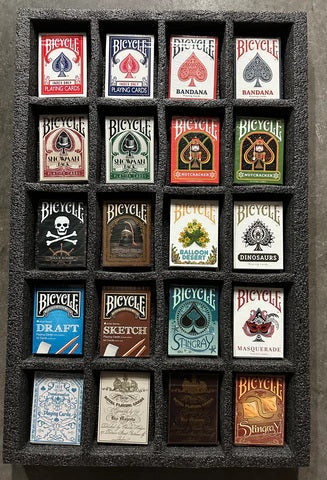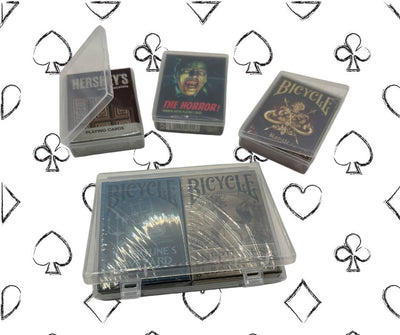by BoardGameGeek reviewer EndersGame
But how about we learn some other activities that we can use our playing cards for? Some of the "how to" videos below will teach you essential skills that everyone should learn how to do, like shuffling cards properly. Others will teach you less common skills, like throwing playing cards, which you can use to impress your friends or family. All of them are easily learned and mastered.
So without further ado, let's get started with some "how to" tutorial videos that will help us acquire new skills with our playing cards!
1. How to throw a playing card
2. How to build a house of cards
Bryan's technique is no secret, and he teaches it openly in some tutorial videos. The key to success is that instead of building with the usual pyramid or triangle shape, you use a grid-like structure based on square shapes. This makes for a much stronger and more reliable house of cards, is easy to learn, and you'll be heading for the ceiling in no time.
What to learn more? See my article: Stacking card houses with world record holder Bryan Berg
3. How to do a riffle shuffle and bridge
There are different ways to shuffle cards, but the two most popular methods are the overhand shuffle and the riffle shuffle. Each involves different techniques, and has different advantages. The overhand shuffle is the most common method, and is what most people learn first. It's practical and fast, but it does keep groups of cards together, and magicians take advantage of this to use it to control individual cards while shuffling. The riffle shuffle is more elegant and sophisticated by weaving cards together, and is the kind of shuffle associated with card games and casinos. When done in the hands it can be finished off by letting the two interwoven packets purr satisfyingly together in what is called a "bridge". It will instantly make you look like a professional, and is worth the minimal effort required to learn it.
4. How to do a card trick
"Gemini Twins" is a true gem among self-working card tricks. It was popularized after it appeared in one of Karl Fulves' books on self-working card magic, and numerous variations exist. You remove two prediction cards face-down from a shuffled deck, and these are used twice to mark the place where your spectator deals from the deck and stops at any point where they wish. When the deck is spread face up, the two prediction cards amazingly turn out to match in colour and value to the exact cards that your spectator stopped at. Despite a simple method that is easy to learn and perform, this is a very strong magic effect.
5. How to do a card flourish
The good news is that there's no right or wrong way to approach cardistry, because you can learn whatever you want. So you have complete freedom to explore whatever suits your preferences and taste. Even so it's good to start by mastering the basics and have somewhat of a graduated approach. Don't focus on rushing things, but try to perform the moves smoothly. And keep practicing, because cardistry is perfect for doing "fiddle moves" while you're watching a movie or waiting for a bus. In this instructional video Chris Ramsay will teach you three basic packet cuts: the swing cut, the swivel cut, and the rotation cut. While the rotation cut is a bit more finicky, you'll master the first two in no time, and you'll be surprised how rewarding it is to do these whenever you have a deck in your hands!
What to learn more? See my article: Top moves and flourishes for complete beginners in cardistry
6. How to play the GOPS card game
It's called GOPS, which is an acronym for "Game Of Pure Strategy", to reflect the fact that there's no luck. But don't go thinking that this is a brain-burner, because it's not that kind of game at all. Instead, it's all about bluffing. Here's the basic concept: You're trying to win the 13 Diamonds cards, which are point cards corresponding to their value. They're shuffled and then revealed one at a time. Players each get an entire suit as their hand (Clubs or Spades), and simultaneously play a card of their choice, with the revealed point card going to the highest played card. The player who wins the most point cards wins the game. The tutorial video will teach you the game in just two minutes, and it's far more fun than you might think!
What to learn more? See my articles: 40+ great card games for all occasions and The best two player games with a standard deck
7. How to play the Exit solitaire game
One of the best non-builder solitaire games is called Exit, or its alternate game Gay Gordons, and was created by card game scholar David Parlett. You set up the game by dealing cards into ten columns of five cards each, plus one column with just two cards. The goal is to eliminate all cards by removing any available pairs that add up to eleven, or a pair of Jacks, or a King/Queen pair. It's super easy to learn, and there's lots of room for planning and decisions because all the cards are dealt face-up. Don't be fooled by the length of this instructional video - the explanation of how to play runs for less than two minutes, and the rest is simply an example of gameplay.
8. How to make a kirigami card
When you look at the final outcome of a kirigami card, it typically has an impossible look, hence the alternative names "impossible cards" or "wow cards". But not all kirigami cards look impossible, and others simply create a beautiful visual aesthetic, or represent an artistic or creative design. And it's not as hard to learn as you might think. Scott typically creates digital designs on his computer first, which he resizes to match a playing card. He's kindly made available all kinds of templates that you can freely download and use. The example in the video is slightly different from Scott's usual kirigami, and shows how to make a mystery box card he calls "Fireworks".
What to learn more? See my article: Creating kirigami cards with Scott Dyer
9. How to make the hypercard illusion
With the help of some scissors and origami, you'll be able to make your own impossible-looking hypercard with a playing card in only a minute. Seriously - it's that simple to make. All you need to do is make three cuts on the card, and then carefully fold the card in two places as taught in the tutorial. The best way to show off the illusion is to insist that people not be allowed to pick it up, but try to wrap their head around the baffling object that they see. If you use a double-backer card, the result looks even more baffling. For just a couple of minutes work, it's well worth the astonishment that the hypercard can create.
10. How to make a three card burr
You will need to use the following template, which will tell you exactly how to cut the three cards. That part is all quite straight-forward and simple, but the real challenge is to assemble the pieces together to make the burr. That's why this even doubles as a puzzle, because you can try to figure out how to put the cards together on your own. You'll have to do quite a bit of bending and fiddling to make it work, and if the idea of finding the solution on your own doesn't interest you, then just watch the tutorial video and follow the instructions. Either way the impossible-looking result is impressive.
Honorable Mentions
Especially if you enjoyed making the hypercard and the three card burr, and want a harder challenge, check out George Hart's card constructions. He's created some wonderful polyhedrons made out of playing cards, and some of the instructional videos below are inspired by his work. A fine example is the 3D card star made out of just 12 cards. If you have the patience to make it, the 30 card global sphere is especially impressive. Once you have exhausted the ones on this list, head over to Scott Dyer, who lists a couple of similar projects.
● How to make a playing card flower
● How to make 3D playing card art
● How to make a 3D card star [reference: alternate video]
● How to make a global sphere [reference: template]
● How to make a turbo cube [reference: template]
Have fun!
About the writer: EndersGame is a well-known and respected reviewer of board games and playing cards. He loves card games, card magic, cardistry, and card collecting, and has reviewed several hundred boardgames and hundreds of different decks of playing cards. You can see a complete list of his game reviews here, and his playing card reviews here. He is considered an authority on playing cards and has written extensively about their design, history, and function, and has many contacts within the playing card and board game industries. You can view his previous articles about playing cards here. In his spare time he also volunteers with local youth to teach them the art of cardistry and card magic.
Last update date: 09/20/22





